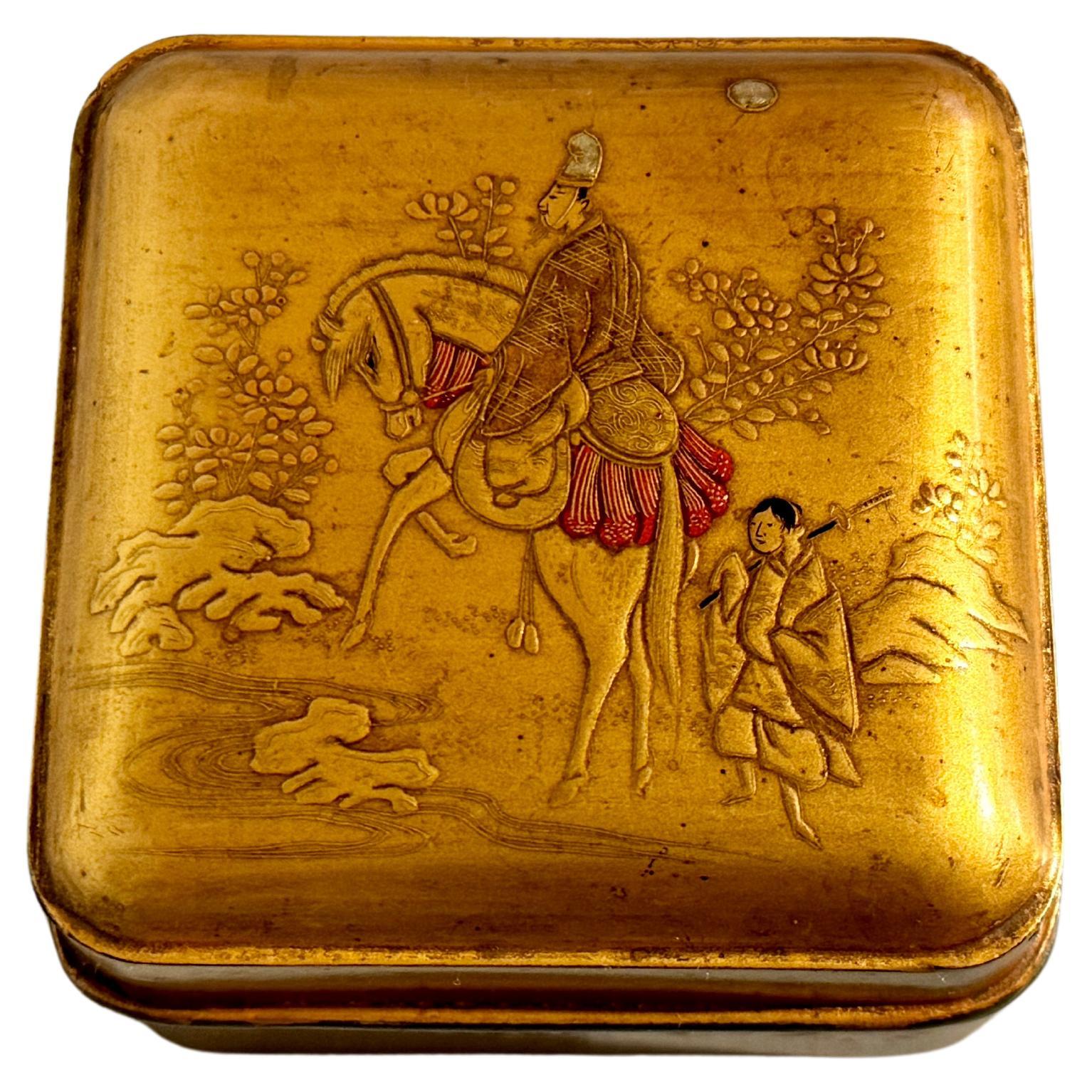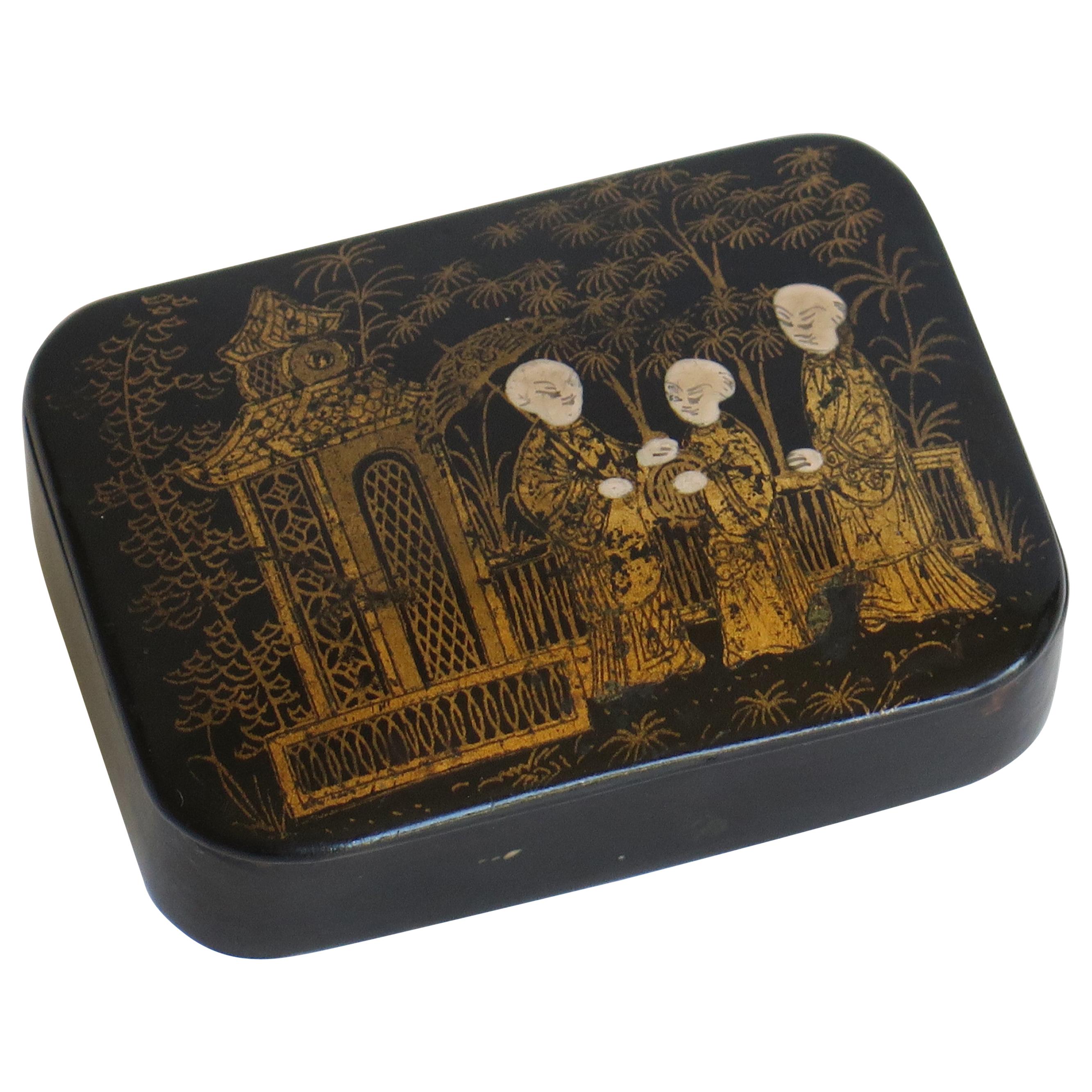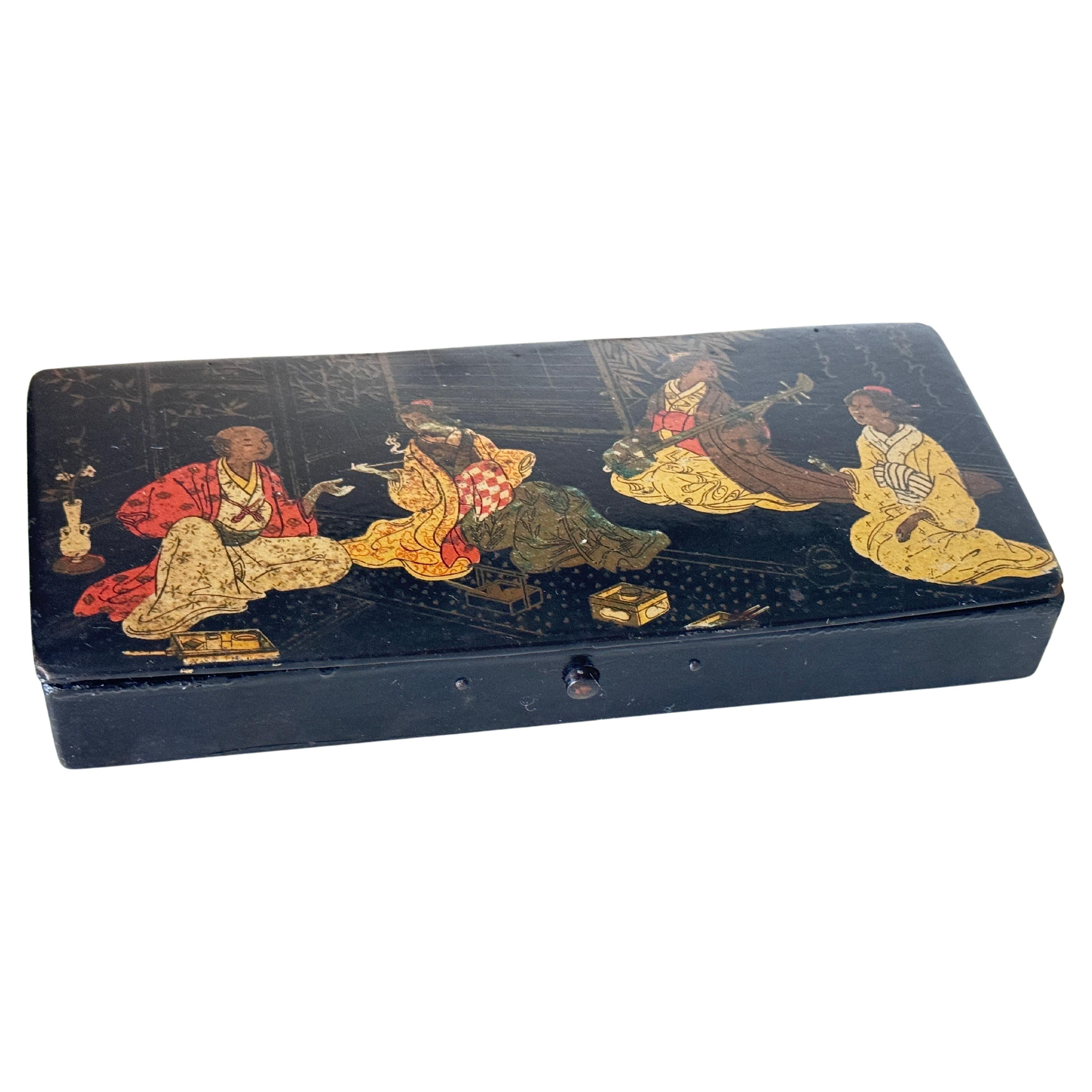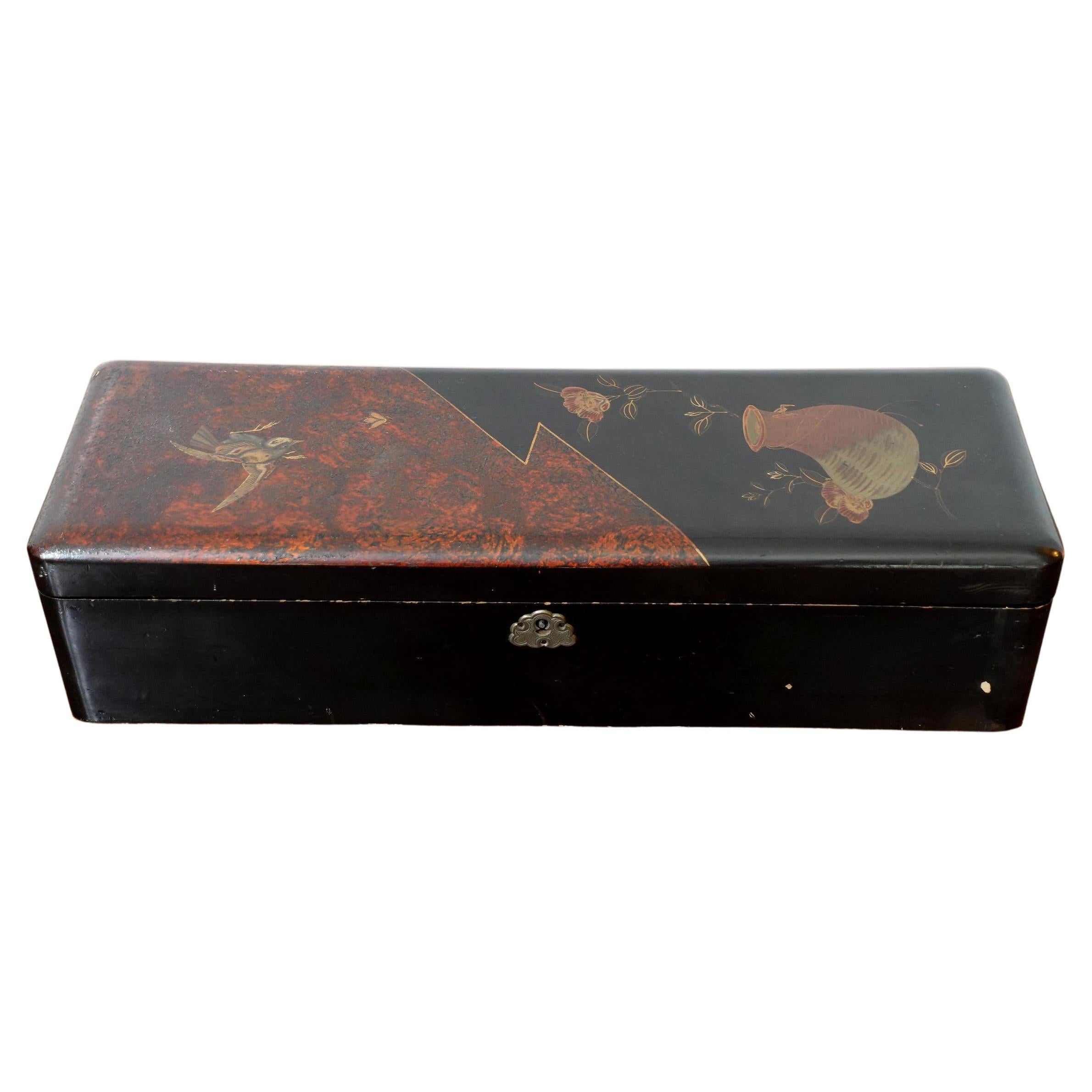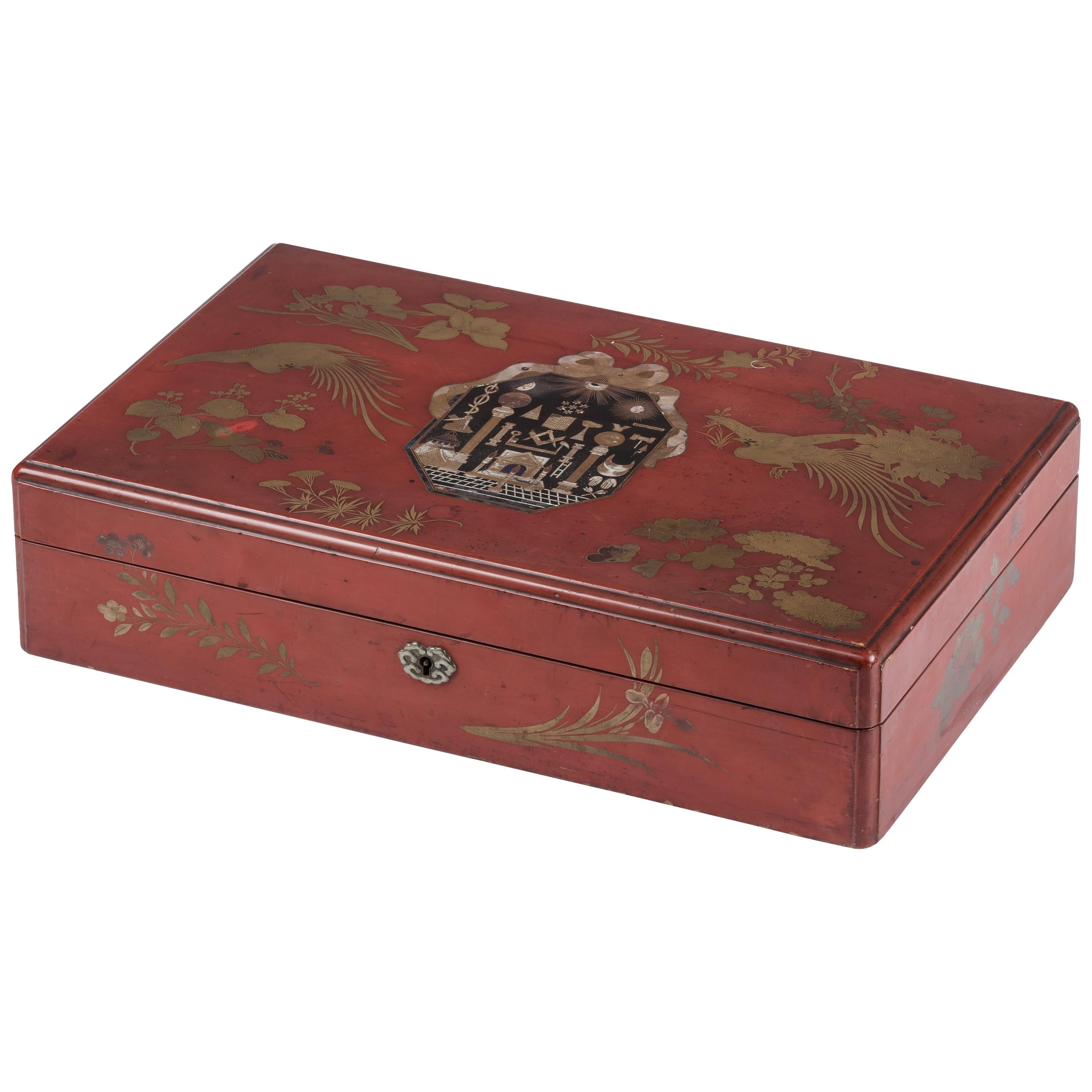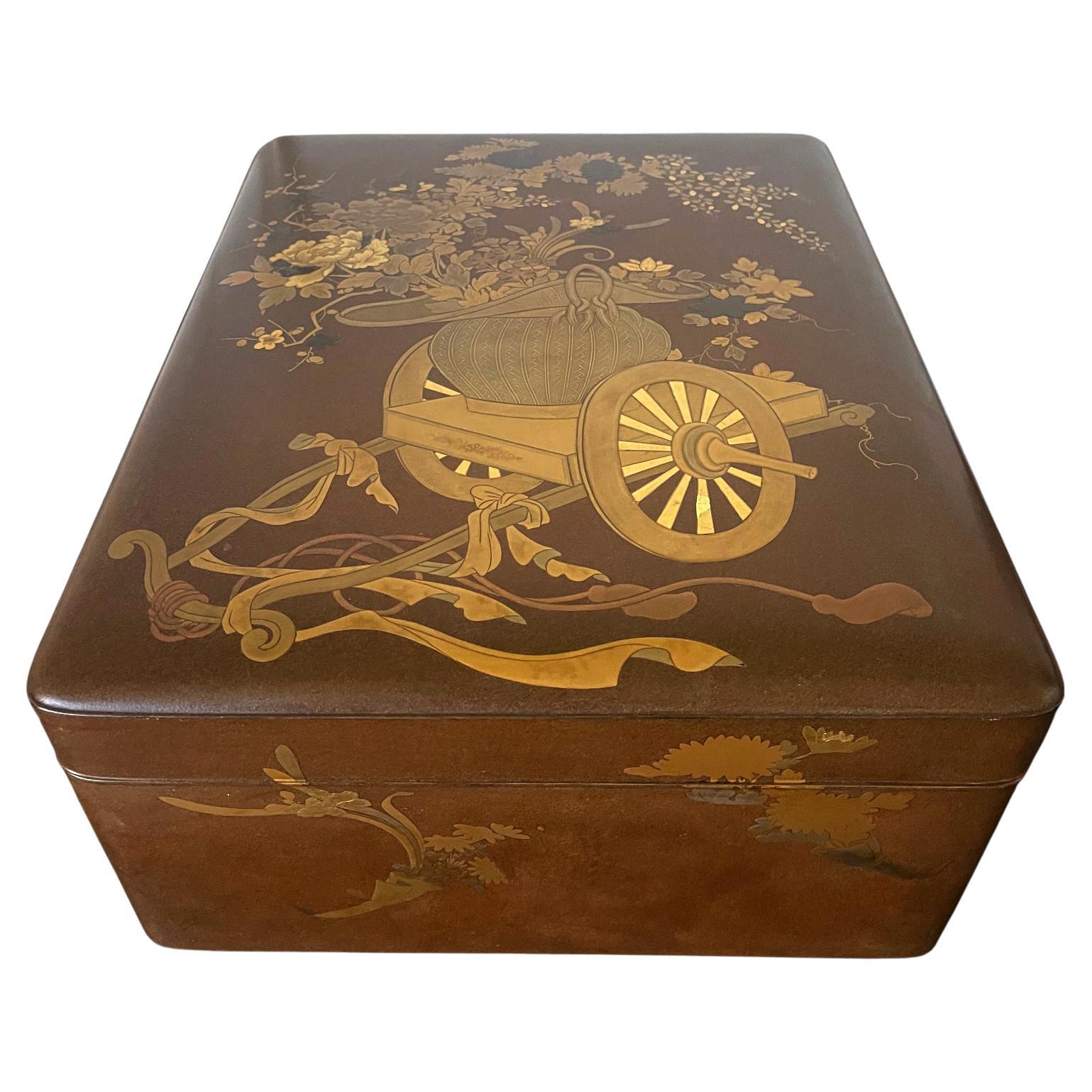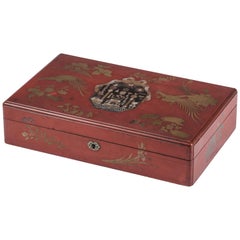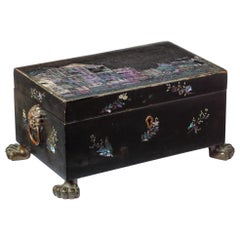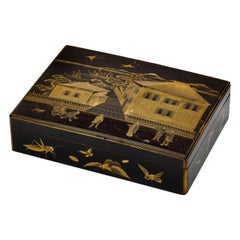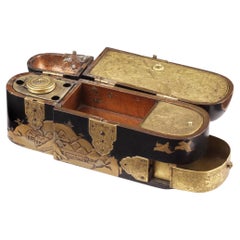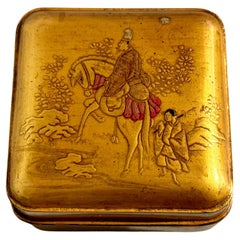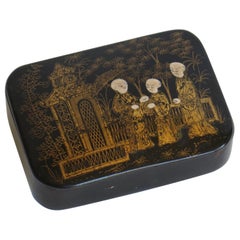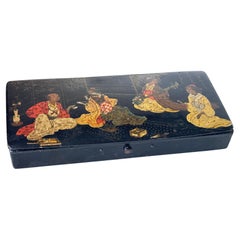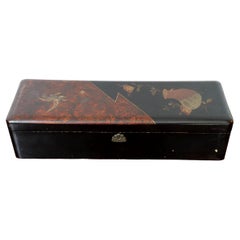Items Similar to Japanese Export Nagasaki Lacquer Box with the Portrait of Napoleon Bonaparte
Want more images or videos?
Request additional images or videos from the seller
1 of 2
Japanese Export Nagasaki Lacquer Box with the Portrait of Napoleon Bonaparte
$11,309.58
£8,406.09
€9,500
CA$15,615.42
A$17,316.34
CHF 9,098.45
MX$211,576.26
NOK 113,834.06
SEK 106,852.71
DKK 72,337.75
About the Item
A Japanese export Nagasaki lacquer tobacco box with the portrait of Napoleon Bonaparte
Edo-period, circa 1810
The box in black lacquer on copper, the lid decorated with a portrait of Napoleon Bonaparte in gold hiramaki-e and nashiji. It has mother-of-pearl inlaid flowers in the four corners inside a similar inlaid border. The sides of the box are likewise decorated with gold lacquer flowers.
H. 2.4 x W. 15.2 x D. 11.3 cm
Who could have ordered this box? The most likely candidate seems to be Herman Willem Daendels (1762-1818). A revolutionary who sided with the Dutch Patriots in 1785, fighting the Orange Stadtholder William V. After the Prussian army came in to support William V, Daendels fled to France because of a death sentence, where he closely witnessed the French Revolution. He returned to the Netherlands in 1794 as a general in the French army under general Pichegru and as commander of the Batavian Legion. In 1806 Napoleon sent his brother Louis Napoleon to rule the kingdom of Holland as a monarch. In 1807 Daendels was appointed as Governor-General of the Dutch East Indies, where he arrived in 1808. There, Daendels did everything he could to prevent the English from occupying the colony. After Napoleon had dismissed his brother as King of Holland in 1810 and incorporated the Netherlands into France, Daendels returned to Holland and moved to Paris where Napoleon appointed him in 1811 as Divisional General and Commander of the 26th Division of the Grande Arme´e. Daendels joined Napoleon on his campaign to Moscow and fought in many battles including the Battle of Berezina. After the fall of Napoleon I, King William I of the Netherlands banned Daendels by appointing him Governor-General of the Dutch Gold Coast (present-day Ghana) where he died of malaria in 1818.
In 1809, when Daendels was Governor-General of the Dutch East Indies, two Dutch ships, the Rebecca and De Goede Trouw sailed from Batavia to Deshima. The Rebecca, with Hendrik Tilenius Kruithoff, the intended successor of Opperhoofd Doeff in Japan, was taken by the English navy. De Goede Trouw, with the Royalist Blomhoff aboard, therefore was the only and last Dutch ship to reach Deshima until 1817. If Daendels indeed ordered this box than it must have been ordered and collected for him in Deshima by the captain or an officer aboard De Goede Trouw.
- Dimensions:Height: 0.95 in (2.4 cm)Width: 5.99 in (15.2 cm)Depth: 4.45 in (11.3 cm)
- Style:Edo (Of the Period)
- Materials and Techniques:
- Place of Origin:
- Period:
- Date of Manufacture:Circa 1810
- Condition:Wear consistent with age and use. Minor losses. Minor fading. We offer restoration, which is not included in the price. Contact us for details.
- Seller Location:Amsterdam, NL
- Reference Number:1stDibs: LU5458233887072
About the Seller
5.0
Recognized Seller
These prestigious sellers are industry leaders and represent the highest echelon for item quality and design.
Established in 1985
1stDibs seller since 2020
23 sales on 1stDibs
Typical response time: 5 hours
- ShippingRetrieving quote...Shipping from: Amsterdam, Netherlands
- Return Policy
Authenticity Guarantee
In the unlikely event there’s an issue with an item’s authenticity, contact us within 1 year for a full refund. DetailsMoney-Back Guarantee
If your item is not as described, is damaged in transit, or does not arrive, contact us within 7 days for a full refund. Details24-Hour Cancellation
You have a 24-hour grace period in which to reconsider your purchase, with no questions asked.Vetted Professional Sellers
Our world-class sellers must adhere to strict standards for service and quality, maintaining the integrity of our listings.Price-Match Guarantee
If you find that a seller listed the same item for a lower price elsewhere, we’ll match it.Trusted Global Delivery
Our best-in-class carrier network provides specialized shipping options worldwide, including custom delivery.More From This Seller
View AllFine Japanese Export Red Lacquer Box with Masonic Symbols, circa 1800
Located in Amsterdam, NL
A fine Japanese export red lacquer box with Masonic symbols
Kyoto/Nagasaki, 1800-1820
Red lacquer decorated with scattered flowers and flying birds with long tails in gold, wit...
Category
Antique Early 19th Century Japanese Edo Lacquer
Materials
Gold
Japanese Nagasaki Export Lacquer Box with Depiction of the 'Trippenhuis'
Located in Amsterdam, NL
A Japanese Nagasaki export lacquer box with mother-of-pearl depiction of the Amsterdam ‘Trippenhuis’
Edo-period, circa 1830
H. 12.5 x W. 24...
Category
Antique 19th Century Japanese Edo Lacquer
Materials
Mother-of-Pearl, Lacquer
A Japanese export lacquer box with depiction of the Grand Hotel, Yokohama
Located in Amsterdam, NL
Meiji period, circa 1873-1887
The black lacquered box decorated in maki-e and hiramaki-e gold, with on the lid a European style building complex and several Japanese and European figures walking along a street in the foreground. The sides are finely decorated with several insects and the inside with several compartments and nashiji decoration.
H. 7.4 x W. 29 x D. 25.7 cm
After the Americans forced Japan to open their harbours to the outside world and take part in international treaty and trade around the mid 19th century, the formerly feudal society rapidly changed. Japan was now focussing on an industrial future. One of the major international ports was Yokohama with its foreign embassies and warehouses - which attracted a great number of visitors of all sorts. For the higher society visiting Japan for the first time a new and ‘Western’ hotel had to be realised; hence the construction of The Grand Hotel on Kaigandori.
The hotel was opened on August 16, 1873 (Meiji 6) and was soon considered the height of Western culture and elegance in Japan. The building probably depicted on this box, designed by American architect Richard P. Bridgens (リチャード・ブリジェンス, 1819 -1891), is the original hotel...
Category
Antique 19th Century Japanese Lacquer
Materials
Gold
Rare 17th Century Japanese Export Lacquer Medical Instrument Box
Located in Amsterdam, NL
A rare Japanese export lacquer medical instrument box
Edo-period, 1650-1700
L. 19 x W. 6 x H. 8.5 cm
This unconventionally shaped lacquer b...
Category
Antique 17th Century Japanese Edo Lacquer
Materials
Gold
Japanese Colonial Nagsaki Lacquer Box with Depiction of Amsterdam, 1830-1840
Located in Amsterdam, NL
An important Japanese lacquer box with a view of The 'Nieuwe Stadsherberg Van Amsterdam
Nagasaki, Edo-period, 1830-1840
The black lacquered wood box, decorated in gold and inla...
Category
Antique Early 19th Century Japanese Decorative Boxes
Materials
Mother-of-Pearl, Wood
$29,762 / item
Free Shipping
A superb Japanese export lacquer writing box
Located in Amsterdam, NL
Kyoto, circa 1680
The writing box has bevelled edges and a kabusebuta (overhanging lid), and is completely covered in black lacquer in maki-e and decorated in gold, silver and red h...
Category
Antique 17th Century Japanese Lacquer
Materials
Lacquer
You May Also Like
Japanese Lacquer Box, Kogo, Tale of Genji, Edo Period, early 19th century, Japan
Located in Austin, TX
A fine Japanese small lacquer box for precious incense, kogo, Edo period, mid 19th century, Japan.
The small box of gold lacquer and wonderfully dec...
Category
Antique Early 19th Century Japanese Edo Lacquer
Materials
Pewter
Japanese Laquered Box with Hinged Lid hand painted, 19th Century Meiji Period
Located in Lincoln, Lincolnshire
This is a good papier mâché, rectangular shaped black lacquered lidded box, hand enamelled and gilded, made in Japan during the 19th century, early Meiji period.
This rectangular shaped papier mâché box has a well fitting hinged lid, with the box base and lid slightly domed. The box was probably originally made as a pocket box but could easily sit on a desk or dressing table as required.
This is a very decorative box with finely hand painted scenes of three people, one holding a parasol, in a garden setting, with a pagoda type building, large gate...
Category
Antique 19th Century Japanese Meiji Lacquer
Materials
Paper
Japanese Lacquered Box Meiji Decorative Box and Ink box, circa 1880
Located in Auribeau sur Siagne, FR
Nice Japanese glove box in red, yellow and black lacquered wood dating from the end of the 19th century. It is decorated with delicate gold, black and red characters.
Inside you have...
Category
Antique 19th Century Japanese Meiji Decorative Boxes
Materials
Wood, Lacquer
$333 Sale Price
20% Off
Japanese Maki-e Lacquered Box, Ric.049
Located in Norton, MA
Japan, Edo to Meiji period, a long rectangular document box with hinged cover, decorated with a bird and a floral basket,
The locker is not functioning.
Category
Antique 19th Century Japanese Decorative Boxes
Materials
Lacquer
Japanese Lacquer Ryoshibako Document Box Meiji Period
Located in Atlanta, GA
A large Japanese lacquer box with elaborate Maki-e design from Meiji period, (mid-late 19th century). The generous size of the box was reser...
Category
Antique 19th Century Japanese Japonisme Lacquer
Materials
Wood, Lacquer
Large Japanese Lacquer Document Box, Ryoshibako, Edo/Meiji period, Japan
Located in Austin, TX
A large and magnificently decorated Japanese lacquer document box, ryoshibako, signed Umeboshi/Baikyo, late Edo or early Meiji Period, mid 19th century, Japan.
The large document box, ryoshibako, of tall, rectangular shape with rounded corners, and fitted with an inrobuta (flush-fitting) cover with beveled edges. The exterior of this exquisite box is decorated all over with fifteen different raised reserves shaped as uchiwa (paddle) fans against a lush and intricate krikane ground imitating shagreen.
The uchiwa shaped reserves all of takamaki-e, and exquisitely painted with designs of animals, flowers, and landscapes in silver, gold, maki-e, hiramaki-e, and takamaki-e, with kirikane, nashiji, and polychrome embellishments, upon gold lacquer fudame grounds.
The interior of the lid is nothing short of spectacular, featuring a large design of a magnificent and beautifully detailed rooster and hen with chicks gathered around a lazy stream. Large stalks of chrysanthemum bloom behind them. All against an ethereal nashiji ground.
The cover of the box features five reserves:
1. Three minogame (turtles with long tails), symbolizing longevity
2. "Narihira Crossing the Sumida" from The Tales of Ise...
Category
Antique 1860s Japanese Meiji Lacquer
Materials
Softwood, Lacquer
More Ways To Browse
French Lacquer
Orange Lacquer
Inlaid Flower
Antique Lacquer Box
Antique Lacquer Boxes
Japanese Lacquer Boxes
Herman Gold
Napoleon Bonaparte
Lacquer Box France
Black Lacquer Mother Of Pearl
Lacquer Campaign
Japanese Lacquer Pearl
Japanese Lacquer And Mother Of Pearl
Japanese Mother Of Pearl Art
Japanese Pearl Of Mother Box
Asian Black Lacquer Pearl Furniture
Occupied Japan
Portrait Of Napoleon
